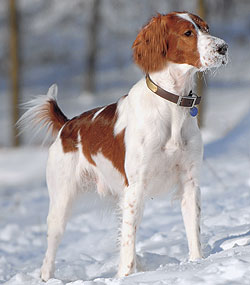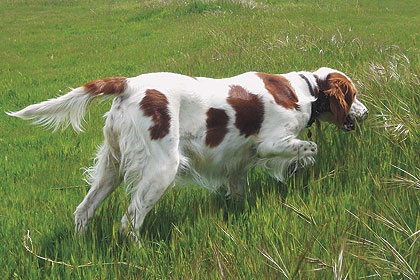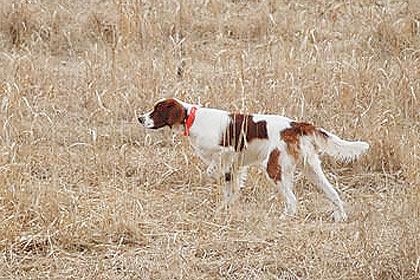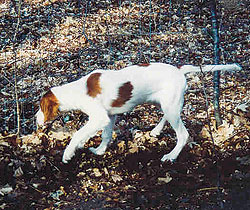Plenty of natural instinct characterizes these handsome newcomers to North America.
By M.J. Nelson
 Rocky (Affinity I Love Rock N Roll), one of Robin Sonsteby's Irish Red and White Setters, demonstrates that the breed's color makes them stand out from the background whether there is snow on the ground or fall color on the trees. Photo by Richard Westley Wong |
If you ask the owners of Irish Red and White Setters, the latest sporting breed to receive full recognition from the American Kennel Club, what makes these dogs special, almost uniformly the answer is, "They are natural pointers." Many say their dogs have earned a junior hunter title with absolutely no training at all and never having had any exposure to birds prior to the time they started running in the tests.
Anyone who has ever trained a pointing dog for the hunt test program would probably agree that yes, indeed, a dog that can successfully pass a junior hunter test with absolutely no prior training on birds is pretty special. "This is a breed that lives to hunt," says Lee Robinson, who is a member of the Irish Red and White Setter Association board of directors and also edits the club newsletter.
"They have great ability to naturally adjust to new hunting conditions and terrain, quartering and hunting deeper in open country and staying close in heavy, thick cover.
They are also capable of hunting other types of game besides upland birds," Robinson continues. "Some of mine are great water dogs, willing to swim long distances to retrieve ducks or geese. However, you have to keep in mind that they do not have the kind of 'insulation' that a Lab or a Chesapeake has for extended severe weather hunts.
"Their white color with red markings makes them easy to track in the field. I live in New England and you need something that stands out from the natural background in the fall with all the color on the leaves or conversely, when there is snow on the ground. The only problem I've ever encountered with this breed is that they have an enormous prey drive that has to be channeled and this generally proves to be the most difficult and challenging aspect of training an IRWS."
 Int. Ch. Waidman's Caoilfhion JH ("Caolin" [pronounced "Kee-lin"]), an IRWS owned by Christina Phillips, on point. The somewhat lower posture is typical of the breed. |
These are "gentleman's hunting dogs," according to Judy Baumgartner, who owns Ch. O'Dobhailien Cailin Alainn JH. "This means they hunt for you, not for themselves and it makes them easy to train for field work. They have so much natural instinct, all you really have to do is control that instinct with commands. They are natural to point so teaching commands like 'whoa' to make them stay until you flush the bird is fairly simple. You just have to be consistent so they know what you are trying to teach.
"They are pretty soft and they don't like to be made to do anything. You get further with this breed with gentle persuasion. They are very intelligent and they catch on fast. They get a lot of pleasure finding game for you. You can see it in the way they look at you when a bird is flushed. They are very proud of themselves."
Bob Devlin, who is vice president of the IRWSA, adds, "This breed has an amazingly high and intense bird instinct. Their intelligence allows them to quickly adapt to all types of upland birds and to hunt the terrain wisely. They are easily trainable even by the most novice trainer if that trainer has a solid, positive connection with the dog.
"They respond to changing voice inflections and positive reinforcement for behavior.
Negative training merely sours them on training. One of the biggest problems we see is that trainers who have trained their gun dogs using negative reinforcement often mistreat the sensitive IRWS. These dogs are the ultimate 'walk-behind, check-back' gun dog. They want to hunt with you and they have a strong desire to please."
 Ch O'Dobhailien Cailin Alainn JH ("Cailin"), Judy Baumgartner's IRWS, is a conformation champion, the first female in the breed to achieve a show championship, and also a hunting dog on her way to her senior hunter title. |
Although the breed was just admitted to the sporting group by the American Kennel Club in January of 2009, the Irish Red and White Setter is really a very old breed€¦older, in fact, than the solid red Irish Setter. Paintings from the 17th century and some written descriptions show and describe white "setting dogges" with red markings. Certainly by the end of the 1700s, the white and red breed was well established.
While there were several varieties of the white and red dogs--travel was not easy in Ireland during the 18th century, thus breeding among the different strains was limited--all the varieties had one thing in common. They were white with red markings ranging from the "shower of hail" coloring to nearly pure white and nearly pure red.
The patched variety that marks the breed today was the most prevalent. It was only through selective and judicious breeding of the nearly solid red dogs that the well-known red Irish setter developed. By the end of the 19th century, the red version had almost completely eclipsed the red and white, which became so rare it was thought for awhile to be extinct.
But during the 1920s, an effort was made to revive the Irish Red and White Setter. Reverend Noble Huston went about gathering the Red and Whites that were still around and recording pedigrees from as far back as roughly 1790. Much of his effort was preserved by Mrs. Maureen Cuddy and in 1978, the Irish Kennel Club rewarded her hard work and dedication when the Red and White was separately classified and given championship status. While still relatively rare in the United States, there are now many Irish Red and White Setters running in field trials or appearing in dog shows in Ireland.
According to those who have worked with them in the field, the natural ability of the breed is what makes them stand out. "Turn one loose in the field and you'll immediately know they were born to hunt," says Christina Phillips. "All of my dogs that have their JH earned qualifying scores in junior with no prior training and my first two had never be
en on any birds prior to running in a hunt test.
"They are such naturals. Most of them point without training, honor a bracemate's point naturally and most are born retrievers. However, a soft touch in training is an absolute must. They can be stubborn sometimes but forcing them may result in a total refusal."
 RBCh Autumwoods Great Lady JH ("Lacey"), owned by Lee Robinson, shows the precocity of the IRWS breed as she was pointing quail at the age of six months. |
Perhaps the reason why these dogs are such "naturals" may stem from the fact that the breed has changed very little in the last 200 years. "They are still the same breed they were 200 years ago," says Robin Sonsteby. "They are a joy to watch in the field and they always seem to be smiling. But I've found that they need to mature mentally before the hard training for advanced work really kicks in. However, they will hunt as young pups and they do a good job in the field. They'll find birds and point them. It's just not the polished performance you'd see from a finished gun dog."
If you insist on a classic breed that points with a 12 o'clock tail the IRWS may not be the breed for you. "Many Irish Red and White Setters will still drop very low to the ground when pointing birds," notes Robinson. "This was necessary in the past when birds were hunted with nets. This is a natural instinct with this breed and has to be taken into consideration when you are training one. It is perfectly normal for this breed."
Since Irish Red and White Setters are scarce in the U.S., both Robinson and Devlin advise caution when buying a pup. "If you want hunting dogs, get your pups from people who hunt their dogs, as the pup's instinct will likely be more intense," says Devlin. "You need to know about the strengths, weaknesses, health issues and whatever else the breeder knows about prior generations. You need to make sure you aren't getting a pup from an 'oops' litter where there are no health clearances.
"If a breeder doesn't let you see health clearances for the parents of the litter, don't buy the pup. The IRWSA wants breeders in the Association to have clearances on their breeding stock for CLAD (Canine Leukocyte Adhesion Deficiency,) hips, CERF (eyes) thyroid panels and for vWD (von Willibrand's Disease), once a reliable genetic test is available in this country.
"Ask to talk with others who own their dogs and visit the breeder to see the parents, if both are available, and all of their other dogs. In other words, don't buy a pup sight unseen over the internet. Another red flag is a breeder that doesn't insist on taking their own pups/dogs back if they need to be re-homed. A major warning sign is a breeder that doesn't question a potential owner to make sure they would make a good owner and be able to provide a good life for one of their pups."
Robinson agrees. "Quality stock comes from reputable breeders," she says. "Contact the Irish Red and White Setter Association (www.irishredwhitesetterassociation.com) as you'll find a wealth of information regarding the breed, breeders, health and a 'buyers' beware.' Make sure the parents are registered with the American Kennel Club or a recognized foreign registry.
"There are still some impure Red and Whites that have been removed from the AKC stud book but are still being bred. This means you should see at least a three-generation certified pedigree on your pup before you buy.
"Contact as many breeders as possible and ask these questions: What health tests have been done on the parents and grandparents of these dogs and do you have proof of these tests? How often do you breed? Can we visit you and meet the dogs? Do you require a personal meeting before you sell your pups? Are your pups raised in the house or in a kennel? Do you hunt with your IRWS and do they have any titles to prove they are capable hunting dogs?
"So far, the breed has not split into 'show' and 'field' factions as has happened to many sporting breeds and I believe it is the responsibility of the parent club to educate breeders, judges and prospective owners so this will never happen to the IRWS. This is a unique hunting dog with a sound temperament, mind and body. It's a breed that is born to hunt!"






